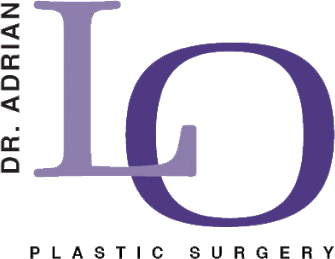The difference between a smooth recovery and weeks of unnecessary discomfort often comes down to knowing what to expect and following the right post eyelid surgery instructions.
Your blepharoplasty recovery time becomes more manageable when you understand the healing process and implement proven strategies to accelerate your progress. With proper preparation and aftercare, you can minimize downtime, reduce swelling, and achieve beautiful results faster than you might expect.
This guide reveals the specific techniques that help patients heal efficiently while avoiding common recovery pitfalls. Understanding your blepharoplasty recovery time allows you to plan work schedules, social commitments, and daily activities around your healing needs.
Related: Lower Blepharoplasty: Before and After
What to Expect During Blepharoplasty Recovery Time
Your eyelid surgery recovery follows stages that help you track your progress toward complete healing. Understanding these phases allows you to prepare properly and recognize normal healing patterns.
First Week Post-Surgery Healing Stage
The initial seven days represent the most important phase of your blepharoplasty recovery time.
Eyelid swelling peaks within the first few days after surgery, creating a puffy appearance around your eyes. Bruising after eyelid surgery typically develops during this period and may extend from your eyelids to your upper cheeks. Your surgical incisions will feel tender, and you may experience mild discomfort that over the counter pain medication effectively manages.
During this period, your eyes may feel dry or gritty due to temporary changes in tear production. These symptoms are normal and gradually improve as your healing progresses.
Second to Fourth Week Recovery Milestones
The second phase of your blepharoplasty healing process brings noticeable improvements in your comfort and appearance.
Swelling begins to subside significantly, though minor puffiness may persist, especially in the mornings. Most bruising fades during this time before completely disappearing.
Your surgical incisions start to mature and become less visible. Many patients return to work at the beginning of the second week, using concealer to camouflage any remaining discoloration. Light activities become more comfortable, though you must continue avoiding strenuous exercise and heavy lifting.
Complete Healing Timeline and Final Results
Full recovery from blepharoplasty typically requires several months, though most patients feel confident in their appearance much sooner.
Final results become apparent once all swelling resolves and your incisions fully mature. The exact timeline depends on your individual healing capacity and the extent of your surgery. How long to recover from eyelid surgery varies from patient to patient.
Minor swelling may persist for several months, particularly in the lower eyelids. This residual puffiness is often only noticeable to you and your plastic surgeon. Complete healing allows you to appreciate the full benefits of your eyelid surgery, including a more youthful and refreshed appearance.
How Long Different Types of Eyelid Surgery Take to Heal
The specific type of blepharoplasty you undergo directly affects your recovery timeline. Each approach involves different surgical techniques and healing considerations that influence your overall eyelid lift recovery time.
Upper Blepharoplasty Recovery
Upper eyelid surgery generally offers the fastest recovery among blepharoplasty procedures. Understanding your expected blepharoplasty recovery time for upper eyelid surgery helps you plan accordingly. Most patients experience minimal swelling and bruising compared to lower eyelid surgery.
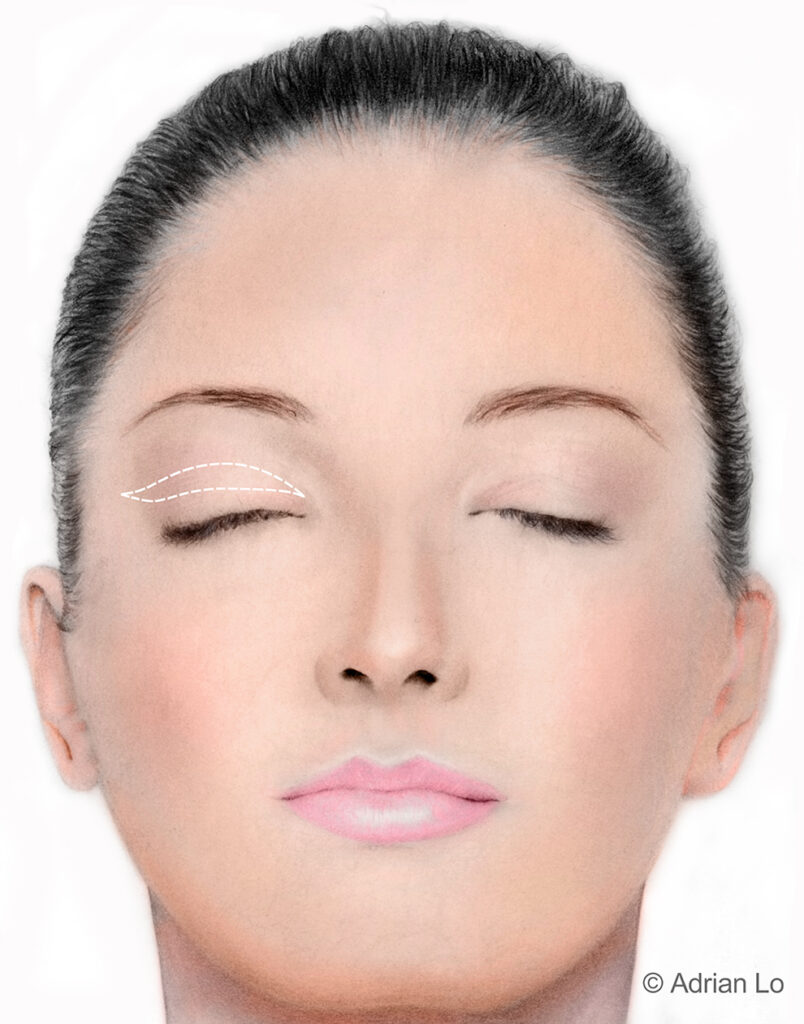
Initial healing occurs within the first week to ten days, with most discomfort resolving during this time. The natural crease of your upper eyelid conceals surgical incisions effectively, making early social activities possible.
Many patients return to work within five to seven days, depending on their occupation and comfort level. Complete healing of upper blepharoplasty typically occurs within six to eight weeks.
Lower Blepharoplasty Recovery
Lower eyelid surgery requires a longer healing period due to the delicate nature of the lower eyelid tissues.
The lower eyelid incision may be on the skin just underneath your eyelashes or on the inside of your lower eyelid. The incision choice will depend on your particular situation and the recommendation of your plastic surgery. Both incisions heal very well and quickly but will have a different recovery time frame.
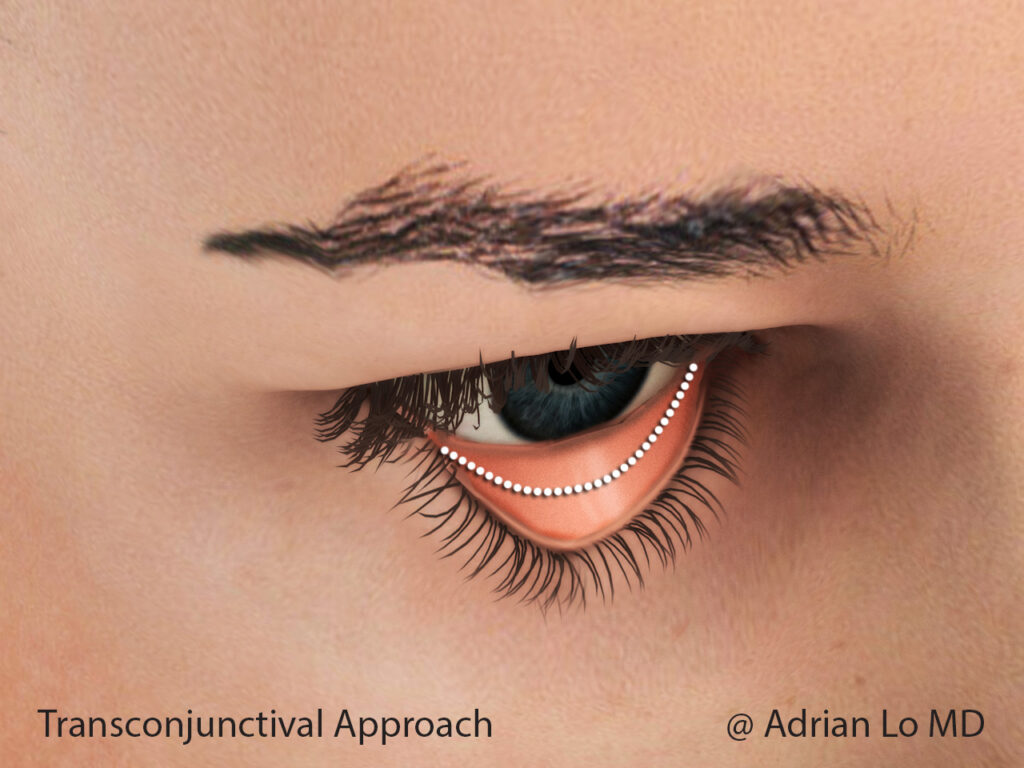
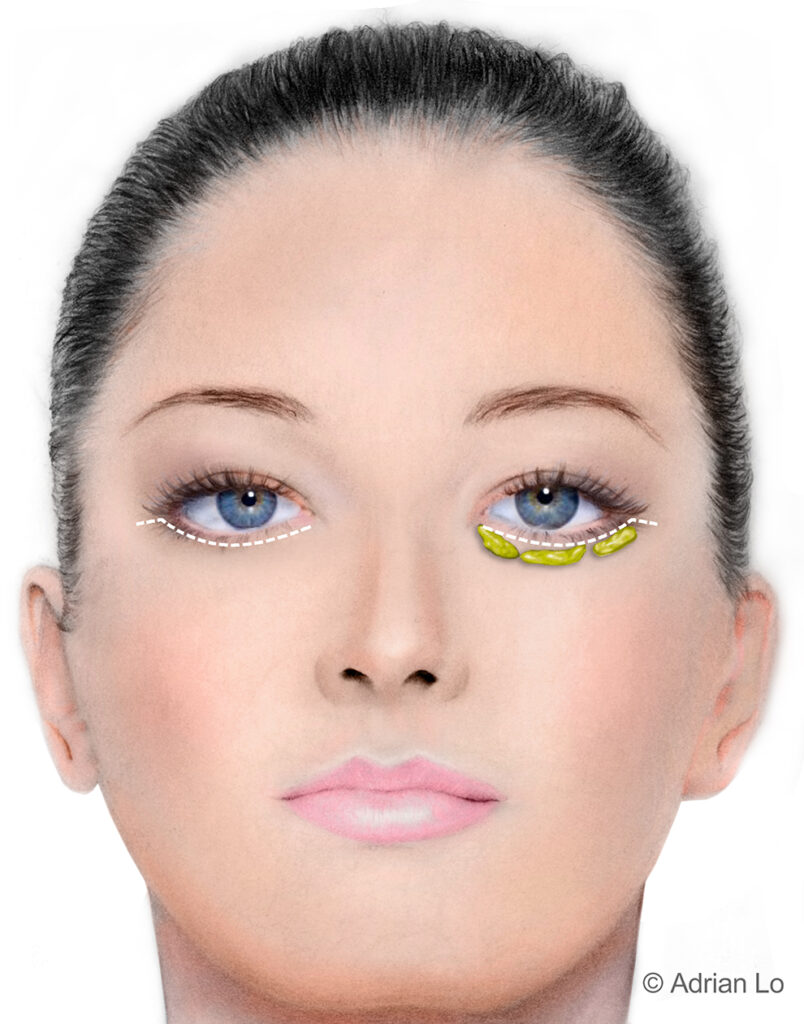
Swelling tends to be more pronounced and persistent in this area. Bruising may extend to your cheeks and can take two to three weeks to completely resolve.
The lower eyelid area tends to swell more than the upper eyelid, making complete recovery longer. Most patients require up to two weeks before feeling comfortable in professional settings. Complete healing may take three to four months for optimal results to become apparent.
Combined Upper and Lower Procedure Recovery
Patients undergoing both upper and lower blepharoplasty should expect a more involved recovery period.
The combination procedure creates more overall healing needs and may require additional time for recovery. Swelling and bruising typically affect the entire eyelid area and may extend to your upper cheeks.
Recovery from combined procedures usually requires two to three weeks before returning to normal activities. The extended healing time allows both surgical sites to recover simultaneously. Final outcomes become visible within one to three months after surgery.
Why Swelling and Bruising Occur After Blepharoplasty
Understanding the causes behind swelling after blepharoplasty helps you maintain realistic expectations and follow appropriate care instructions. These symptoms represent normal healing responses that can be managed effectively with proper aftercare.
Normal Inflammatory Response Following Surgery
Bruising occurs when small blood vessels are disrupted during the procedure.
Your body responds by sending healing cells to the surgical site, causing swelling and temporary discoloration. This response is necessary for proper healing and can be effectively managed with proper care.
The thin skin around your eyes shows bruising more readily than other body areas. Blood pooling under the skin creates the characteristic discoloration associated with healing. This process follows a consistent pattern and gradually resolves as your body heals the affected tissues.
Individual Factors That Influence Healing Speed
Several personal factors affect your individual recovery timeline.
Age plays a significant role, as younger patients typically heal faster than older individuals. Your overall health status, including cardiovascular fitness and nutritional status, influences how quickly your body repairs surgical sites.
Genetic factors also contribute to your healing speed and tendency toward swelling or bruising. Some patients naturally produce more inflammatory responses, while others heal with minimal visible symptoms. Pre-existing conditions like allergies or certain medical conditions may extend your recovery timeline.
When to Contact Your Plastic Surgeon About Symptoms
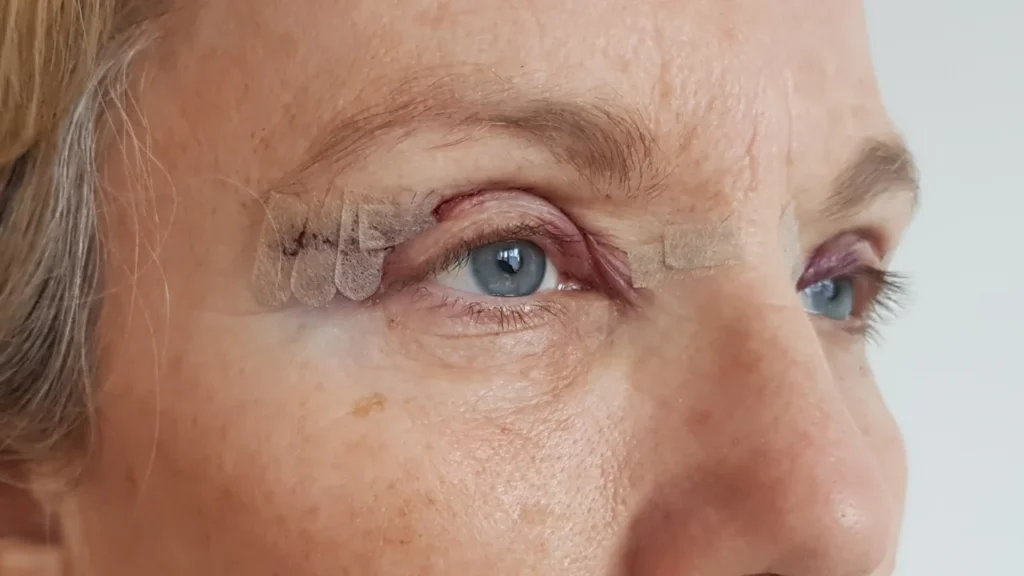
While swelling and bruising are expected after blepharoplasty, certain symptoms warrant immediate medical attention.
Severe swelling or pain that worsens instead of improving may indicate complications requiring treatment. Vision changes beyond mild blurriness should be evaluated promptly by your plastic surgeon.
Signs of infection include increased redness, warmth, or discharge from your surgical incisions. Fever or unusual swelling that develops after initial improvement also requires professional evaluation. Contact your plastic surgeon immediately if you experience any concerning symptoms during your recovery.
Essential Blepharoplasty Aftercare Tips for Faster Healing
Following comprehensive blepharoplasty aftercare tips significantly improves your healing speed and final results. These evidence-based strategies help minimize complications and optimize your recovery experience.
Proper Incision Care and Cleaning Techniques
Gentle cleaning of your surgical incisions prevents infection and promotes optimal healing.
Use sterile saline solution to remove any discharge or crusting. Use soft cotton swabs, working from the inner corner to the outer corner of your eye to clean the area.
Pat the area dry with clean tissues rather than wiping across the surgical sites. Apply prescribed antibiotic ointments as directed by your plastic surgeon to maintain moisture and prevent bacterial growth. Consistent, gentle care keeps your incisions clean and healing properly.
Temporary dryness of your eyes and grittiness can be treated with lubricating eye drops throughout the day as directed by your plastic surgeon. Lubricating eye ointment may also be recommended for use while sleeping at night.
Sleep Position and Head Elevation Requirements
Proper sleeping position impacts your recovery by reducing swelling accumulation.
Sleep with your head elevated above your heart level for the first two weeks after surgery. Use multiple pillows or a wedge pillow to maintain this position comfortably throughout the night.
Back sleeping positions work best during initial recovery. Some patients find reclining chairs more comfortable than beds during this period. Consistent elevation helps lymphatic drainage and minimizes morning puffiness for improved comfort.
Activity Restrictions and Exercise Guidelines
Following activity guidelines minimizes bruising and swelling during your healing process.
Refrain from heavy lifting, vigorous exercise, and bending over for at least two weeks after surgery. These activities increase blood pressure in your head and can disrupt healing tissues.
Light walking is encouraged to maintain circulation and prevent complications. Gradually increase your activity level as your plastic surgeon approves. Most patients can resume normal exercise routines at 3-4 weeks, though contact sports may require additional recovery time.
Eye Protection and Environmental Precautions
Protecting your eyes from environmental irritants supports optimal healing and prevents complications.
Wear sunglasses when outdoors to shield your healing incisions from wind, dust, and ultraviolet radiation. Choose wraparound styles that provide comprehensive coverage without pressure on your surgical sites.
Avoid swimming pools, hot tubs, and saunas for at least two weeks after surgery. These environments harbor bacteria that can cause infections in healing wounds. Similarly, avoid dusty or smoky environments that may irritate your sensitive eye area during recovery.
How to Minimize Swelling After Blepharoplasty
Implementing strategies to reduce swelling accelerates your recovery and improves your comfort level. These proven techniques work synergistically to promote faster healing and better outcomes.
Cold Compress Application Methods
Cold compresses provide immediate relief and reduces swelling when applied correctly.
Use specialized cold packs or frozen vegetables wrapped in medical gauze or thin towels to prevent direct skin contact. Apply cold therapy for ten to fifteen minutes every hour during your waking hours for the first two days after surgery.
Gentle, consistent application works better than prolonged exposure. Award-winning plastic surgeon recommendations emphasize proper technique for optimal results.
Dietary Modifications to Reduce Inflammation
Specific dietary changes can significantly impact your healing speed and swelling levels.
Reduce sodium intake to minimize water retention that contributes to facial puffiness. Increase consumption of anti-inflammatory foods like berries and leafy greens.
Stay well-hydrated by drinking plenty of water, which helps your body eliminate toxins and maintain healthy circulation. Avoid alcohol for at least two weeks, as it can interfere with healing and increase bleeding risk. Limit caffeine intake, which can affect sleep quality needed for optimal recovery.
Supplement and Medication Considerations
Certain supplements may help reduce inflammation and promote faster healing, though you should always consult your plastic surgeon before adding anything to your routine.
Arnica preparations may help minimize bruising, though you should discuss options with your plastic surgeon first. Follow your plastic surgeon’s specific medication guidelines for optimal results.
Vitamin C supports collagen production and healing when taken as directed. Your plastic surgeon will provide detailed instructions about which medications to avoid and which may benefit your recovery.
Professional Blepharoplasty Care in Philadelphia with Dr. Adrian Lo
Dr. Adrian Lo provides comprehensive blepharoplasty services with personalized recovery plans designed to optimize your healing experience. His expertise in advanced eyelid surgery techniques ensures minimal downtime and beautiful results for patients seeking facial rejuvenation.
Philadelphia plastic surgery patients benefit from detailed aftercare instructions and ongoing support throughout their recovery journey. Schedule a consultation to discuss your blepharoplasty goals and learn how proper planning can enhance your recovery experience.
